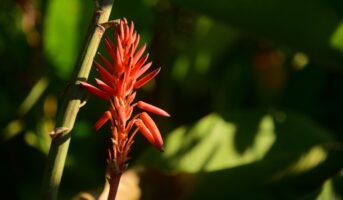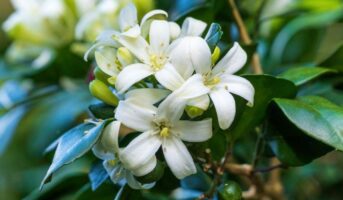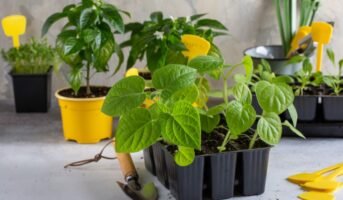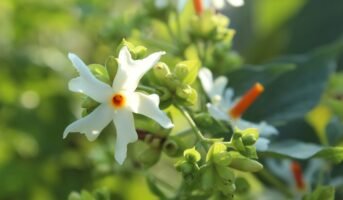Alocasia macrorrhizos is a species of flowering plant in the arum family. They have their origin in the rainforests ofSoutheast Asia, New Guinea, and Queensland. Today they are grown all over Asia and Europe mostly as a food crop. It forms an important source of starch and is an important crop in many countries. The plant also goes by its common names like giant taro, ape, giant alocasia, biga, and pia. They are available in original and variegated varieties.

Source: Pinterest
Alocasia macrorrhizos grows from tubers and can rise up to great heights. The leaves stem from the tubers under the growth and can rise about 6 feet above the surface. They can be easily propagated through sliced tubers in the summers and spring. The plant has big and broad leaves that are curly on the edges. A hard stem is missing and the new leaves grow from between the old leaf stems. They flower very rarely and produce large single petal flowers with a grainy stalk in the middle.
See also: Know all about Scadoxus multiflorus
Key facts
| Name | Alocasia macrorrhizos |
| Common name | Giant taro, ape, giant alocasia, biga, and pia. |
| Type | Foliage |
| Height | A few feet above the ground |
| Indoor/Outdoor | Both |
| Origin | Southeast Asia, New Guinea, and Queensland |
| Soil | Moist and well drained |
| Water | Moderate |
| Sunlight | Bright indirect light |
| Humidity | High humidity |
Benefits of Alocasia macrorrhizos
Alocasia macrorrhizos is a great indoor plant that is mostly grown as foliage in Western countries. Its big green leaves add a touch of greenery to any space and the plant can even grow indoors. It is also grown as a food crop in Asia and Europe where it is used in a variety of cuisines. Additionally, Giant Taro or Alocasia macrorrhizos also comes with many medicinal properties. It can help cure diseases and restore nutrition in the body.

Source: Pinterest
Here are a few benefits of consuming Alocasia macrorrhizos for health purposes:-
Enhances optical health
Vitamin E lowers the chances of macular degeneration which is an age related eye disease that is the cause for blindness. It should be consumed with beta carotene, vitamin C and zinc. The study shows that high intake of Vitamin A and Vitamin E improves the vision and healing in the people who have undergone laser eye surgery.
Treats skin problems
Alocasia macrorrhizos has a high amount of Vitamin C. This vitamin is essential for maintaining healthy skin. It helps reduce pigmentation, fine lines, wrinkles, acne, and pimples. Additionally, it casts a healthy glow on the skin and nourishes it from within.
Has antioxidant properties
Vitamin C content of Alocasia macrorrhizos acts as an antioxidant that can prevent cell damage caused by free radicals. Additionally, it can save the body from pollutants and toxic chemicals. It can even eliminate risks of cancer by protecting the body.
Eliminated Vitamin deficiency
Alocasia macrorrhizos has high levels of vitamins that can replenish the body. The plant is a rich source of Vitamin C that is required by the body. It can be consumed daily in place of vitamin supplements. People who suffer from acute vitamin deficiency should include taro in their diet to restore their daily vitamin intake.
Cures insomnia
Giant taro or Alocasia macrorrhizos has high levels of magnesium that can help cure insomnia. Magnesium supplements are prescribed to patients with insomnia as it helps increase sleep time. It also lowers cortisol levels that cause stress.
Improves heart health
Magnesium prevents the irregular heartbeats, heart damage and muscle stress. It soothes the nerves and mediates the digestive processes which prevent the ailments such as indigestion, vomiting, cramps, flatulence, abdominal pain and constipation. The deficiency of magnesium increases the chances of fatal heart disease.
FAQs:
Is Giant Taro an indoor plant?
Giant taro or Alocasia macrorrhizos can be grown as an indoor plant. It can survive in bright indirect light as long as you take care of it. However, make sure to place them in an area that stays illuminated by sunlight for at least 4 hours a day.
Is alocasia Macrorrhizos toxic to animals?
Yes, alocasia Macrorrhizos is toxic to animals. It can cause severe symptoms like vomiting, nausea, diarrhea, and so on. Pet parents are recommended not to plant this at home.
Are elephant ears poisonous to touch?
Elephant ear plant or Alocasia macrorrhizos is not poisonous to touch. However, in rare cases it can cause allergic reactions.
Housing News Desk is the news desk of leading online real estate portal, Housing.com. Housing News Desk focuses on a variety of topics such as real estate laws, taxes, current news, property trends, home loans, rentals, décor, green homes, home improvement, etc. The main objective of the news desk, is to cover the real estate sector from the perspective of providing information that is useful to the end-user.
Facebook: https://www.facebook.com/housing.com/
Twitter: https://twitter.com/Housing
Email: [email protected]











